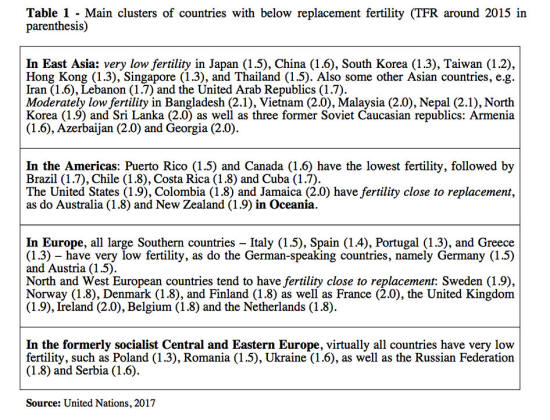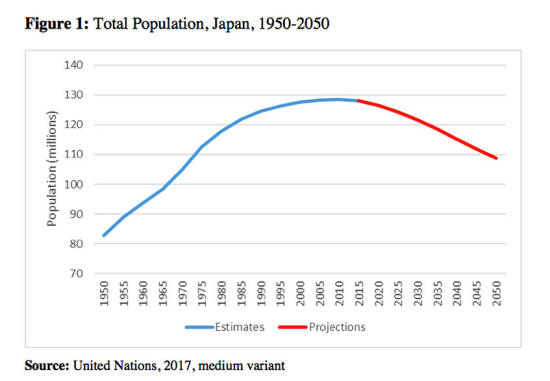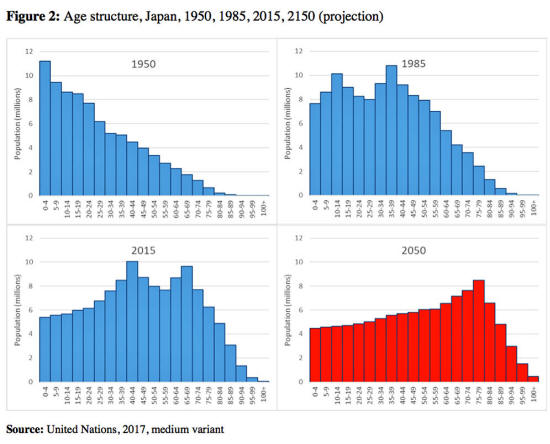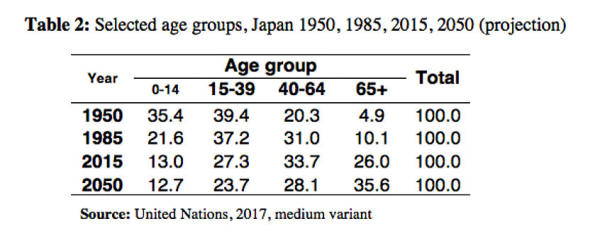|

by Tomas Frejka
December 04,
2017
from
N-IUSSP Website

Overestimates of population growth
are
fraudulent.
Google returns
7.5 million results for the word 'overpopulation',
all of which are ignorant, if not outright
fraudulently claiming that population is the blame
for everything.
Here is a
typical propaganda statement:
Human
overpopulation is among the most pressing
environmental issues, silently aggravating the
forces behind global warming, environmental
pollution, habitat loss, the sixth mass
extinction, intensive farming practices and the
consumption of finite natural resources, such as
fresh water, arable land and fossil fuels, at
speeds faster than their rate of regeneration.
Population
fear-mongering is a total fraud, similar
to global warming,
used to drive
the U.N.'s
Sustainable Development agenda.
Source
Half the
world's population reaching below replacement fertility
According to the
most recent UN estimates (United Nations 2017), almost one half of
the world's population lives in countries with below replacement
fertility (BRF),
i.e. with a total fertility rate (TFR)
below 2.1 births per woman.
Of these, one
quarter have TFRs close to the replacement level, i.e. between 1.8
and 2.1; the other three-quarters have really low fertility, below
1.8 births per woman.
Low-fertility
countries are generally grouped into clusters.
The main clusters
are in,

In fact,
contemporary fertility around the globe is lower than it has ever
been.
Since the middle of
the 20th century, childbearing has declined by 50
percent:
50 to 60 years
ago women in developed and developing countries combined had on
average 5 children, but now the world average is about 2.5
children per woman.
Why do so many countries
have below replacement fertility?
Early in the 20th century it became obvious that family
size was declining in countries experiencing substantial industrial
and urban growth.
A number of French,
British and American social scientists set out to map and explain
this change. Perhaps the most comprehensive and profound
explorations were conducted by a team of scholars at Princeton
University's Office of Population Research.
Frank Notestein,
its first director, outlined what had transpired by mid-20th
century, including the main causes for the changing family size, in
two papers dealing with what is now known as the "demographic
transition" (Notestein 1945 and 1953).
Much of the
following summary applies even today:
The new ideal
of the small family arose typically in the urban industrial
society. It is impossible to be precise about the various causal
factors, but apparently many were important.
Urban life
stripped the family of many functions in production,
consumption, recreation, and education. In factory employment
the individual stood on his own accomplishments.
The new
mobility of young people and the anonymity of city life reduced
the pressures toward traditional behavior exerted by the family
and community.
In a period of
rapidly developing technology new skills were needed, and new
opportunities for individual advancement arose.
Education and a
rational point of view became increasingly important. As a
consequence the cost of child-rearing grew and the possibilities
for economic contributions by children declined.
Falling death
rates at once increased the size of the family to be supported
and lowered the inducements to have many births.
Women,
moreover, found new independence from household obligations and
new economic roles less compatible with child-rearing.
(Notestein
1953:17)
Since then,
fertility trends and levels, and their causes and consequences have
been the most researched topics in population studies.
However, despite
the hundreds of published studies, it appears that Notestein's
observation continues to be valid:
"it is
impossible to be precise about the various causal factors, but
apparently many were important".
In addition to,
-
never-ending advances in technology
-
the
continuous need for new skills
-
the
indispensable need for education
-
the
persisting rise in costs of childrearing
-
continued
mortality decline
-
the steady
rise in women's status,
...important
causal factors generating contemporary BRF since around the 1960s
appear to be weakening economic and social conditions for large
swaths of the population.
These include often
imperfect social and family policy measures; the improving quality,
variety, and access to means of birth regulation; and the gender
revolution (Frejka 2017).
In the West, consisting of,
-
Western,
Southern and German-speaking Europe
-
North
America
-
Japan
-
other East
and South-East Asian countries,
...economic
and social conditions are not as favorable as in the post-Second
World War period.
Various beneficial
aspects of the "welfare state" have been whittled away. The level of
real income has been stagnating, and
income inequality increasing.
Employment levels
have been fluctuating. Unemployment among young people has been
relatively high and employment insecurity is widespread. The cost of
housing has been increasing, making it difficult for young people to
secure decent homes.
All of these
conditions have contributed to the fact that young people are short
on means and have postponed marriage and childbearing (Cherlin 2014,
Hobcraft & Kiernan 1996).
On the cusp of the 1990s, formerly socialist Central and East
European countries experienced a fundamental transformation from
paternalistic conditions of relatively secure employment, low-cost
housing, free education, free health care and various family
entitlements to the economic and social conditions of contemporary
capitalism just described above.
The concomitant
decrease in fertility and family size comes as no surprise (Frejka
and Gietel-Basten 2016).
In China, the strictly enforced one-child policy on top of
extraordinarily rapid industrialization and urbanization was
instrumental in lowering childbearing.
In all these countries, women have entered paid employment in vast
numbers, especially since the 1950s, shouldering not only household
chores, childbearing and childrearing, but also securing a
significant part of family income.
Often the needs of
the family and work collide, taking a toll on childbearing. Men have
started to contribute to household chores and childrearing, but only
in part and at a slower pace than women entering the "public
sphere."
As a whole, these
developments constitute what is known as the gender revolution
(Frejka et al. 2017).
The improved availability of a widening range of contraceptive means
- often labeled as the contraceptive revolution - and the
gradual legalization of induced abortions in many countries along
with safer methods of performing abortions have made it easier for
people to achieve whatever their desired family size might be.
Consequences of below
replacement fertility
Knowledge about the demographic consequences of fertility trends is
among the most important basic ingredients for long-term and
short-term policy making and planning.
Nowadays fertility
and its effects can be projected reasonably well for the near future
of 10-15 years, but also over longer periods, for which a set of
alternative projections can be calculated.
Such information is
indispensable for planning and costing educational institutions,
health care systems and social security systems, for example. It
also serves to determine the availability of human resources for the
labor market or for military purposes, or to calculate immigration
and emigration probabilities.
Let us take the example of Japan which is a relatively closed
population without much migration, in or out. Fertility declined to
below replacement in the late 1970s, and is currently at about 1.4
births per woman.
Because of
population momentum, the Japanese population was still growing until
around 2010, but it started to shrink thereafter and is likely to
continue to do so for decades (Figure 1).

Changes in Japan's
age structure are depicted in Figure 2 and Table 2 for the years
between 1950 and 2050.


In 1950 the
majority of the population was young, and only 5 percent was 65
years old and over. By 2015 a full one quarter was aged 65 and over,
and by 2050 the proportion will likely rise to 36 percent.
The social and
economic costs of such an abrupt change in such a historically short
time are difficult to evaluate:
its impact on
the pension and health system, family structures, labor
productivity, etc. is enormous.
Japan, followed by
many other countries, is heading towards a path never experienced in
human history, and that appears to be full of unknowns.
Conclusion
Some may consider below replacement fertility and the ensuing
population decline as a positive development because it may lead to
a reduced need for, and to actual lower consumption of resources,
such as food, fuels, and housing (Grossman, 2017).
However, population
decline is necessarily accompanied by profound changes in the age
structure, and by a considerable increase in the share of old people
that, too, has its costs.
The general world trend is for a continued fertility decline and for
an increasing share of countries joining those with below
replacement fertility. When this decline is fast, profound or
prolonged, the consequences may be difficult to handle.
But this destiny is
not unavoidable:
a few
countries, especially in Northern Europe, which also experienced
a fertility decline, have been successful in maintaining levels
close to replacement.
So the good news is
that declining fertility may be stopped before it gets too low or
may even be reversed.
How that can be
done, however, may require another article in N-IUSSP.
References
-
Cherlin,
Andrew J. 2014. Labor's Love lost: The Rise and Fall of the
Working-Class Family in America. The Russell Sage
Foundation.
-
Frejka,
Tomas. 2017. "The fertility transition revisited: A cohort
perspective," Comparative Population Studies, 42:89-116.
-
Frejka,
Tomas and Stuart Gietel-Basten. 2016. "Fertility and Family
Policies in Central and Eastern Europe after 1990."
Comparative Population Studies. 41 (1): 3-56.
-
Frejka,
Tomas, Frances Goldscheider and Trude Lappegård. 2017. "The
Two-part Gender Revolution, Women's Second Shift and
Changing Cohort Fertility." Stockholm Research Report in
Demography. SSRD 2017:23
-
Grossman,
Richard. 2017. The world in which the next 4 billion people
will live. N-IUSSP
-
Hobcraft,
John and Kathleen Kiernan. 1995. "Becoming a parent in
Europe." In: European Population Conference 1995. Evolution
or Revolution in European Population. Vol. 1. Plenary
Sessions. Milano. 27-65.
-
Notestein,
Frank W. 1945. "Population - The Long View." in Schultz,
Theodore W. ed. 1945. Food for the World. 36-57.
-
Notestein,
Frank W. 1953. "Economic Problems of Population Change." In
Proceedings of the Eighth International Conference of
Agricultural Economists. New York. 13-31.
-
United
Nations. 2017. World Population Prospects: The 2017
Revision, Key Findings and Advance Tables. ESA/P/WP/248.
|






